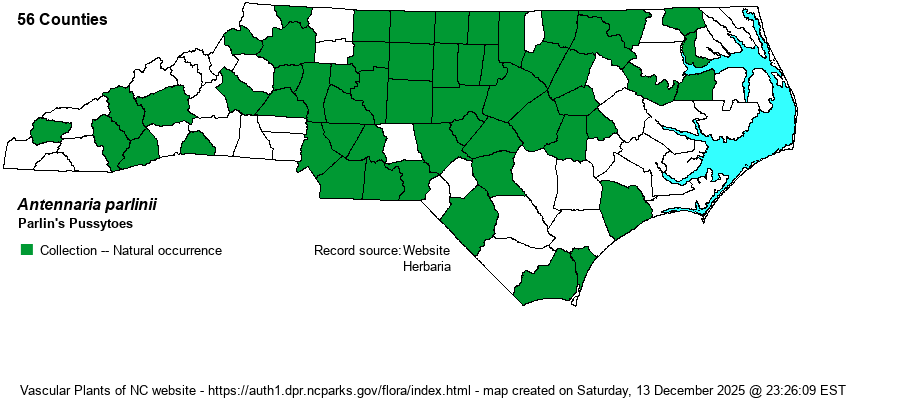| Author | Fernald | |
| Distribution | Mostly Piedmont and upper Coastal Plain; scattered in the Mountains and the reminder of the Coastal Plain; apparently absent from the Sandhills region proper, as well as in the far eastern counties.
N.S. to southern Ont. and SD, south to GA and TX. | |
| Abundance | Apparently fairly common to frequent in most of the Piedmont; uncommon or infrequent in the rest of the state, but very rare to absent in the extreme northeastern counties and likely also the Sandhills. | |
| Habitat | Dry pine-hardwoods, openings, fields, and roadsides. |
| Phenology | Flowering and fruiting April-May. | |
| Identification | Both subspecies of A. parlinii have 3-5 prominent nerves on the basal leaves, as opposed to Howell's Pussytoes (A. howellii) and Field Pussytoes (A. neglecta), which both have just one. From Plantain-leaf Pussytoes (A. plantaginifolia), Parlin's differs in its taller female florets and floral bracts (involucres), and taller male florets -- see Weakley (2024) for details. In addition, Plantain-leaf Pussytoes is densely hairy on the upper surfaces of leaves (vs. glabrous or hairy only when young in Parlin's Pussytoes). | |
| Taxonomic Comments | Some authors lump ssp. fallax as var. ambigens within A. plantaginifolia. Some authors lump ssp. parlinii as var. arnoglossa within A. plantaginifolia.
| |
| Other Common Name(s) | None | |
| State Rank | S4 [S5] | |
| Global Rank | G5 | |
| State Status | | |
| US Status | | |
| USACE-agcp | | |
| USACE-emp | | |

